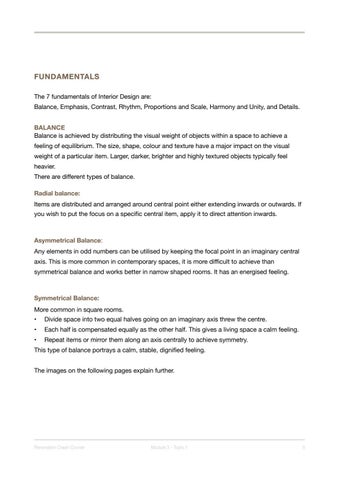FUNDAMENTALS The 7 fundamentals of Interior Design are:
Balance, Emphasis, Contrast, Rhythm, Proportions and Scale, Harmony and Unity, and Details.
BALANCE Balance is achieved by distributing the visual weight of objects within a space to achieve a feeling of equilibrium. The size, shape, colour and texture have a major impact on the visual weight of a particular item. Larger, darker, brighter and highly textured objects typically feel heavier.
There are different types of balance.
Radial balance:
Items are distributed and arranged around central point either extending inwards or outwards. If you wish to put the focus on a specific central item, apply it to direct attention inwards.
Asymmetrical Balance:
Any elements in odd numbers can be utilised by keeping the focal point in an imaginary central axis. This is more common in contemporary spaces, it is more difficult to achieve than symmetrical balance and works better in narrow shaped rooms. It has an energised feeling.
Symmetrical Balance:
More common in square rooms.
•
Divide space into two equal halves going on an imaginary axis threw the centre.
•
Each half is compensated equally as the other half. This gives a living space a calm feeling.
•
Repeat items or mirror them along an axis centrally to achieve symmetry.
This type of balance portrays a calm, stable, dignified feeling.
The images on the following pages explain further.
Renovation Crash Course
Module 3 - Topic 1
"5







